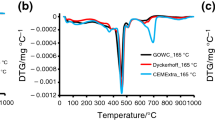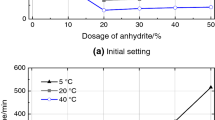Abstract
The main purpose of this work is to demonstrate the potential of calcium sulfoaluminate (CSA) cement for thermoelectric energy storage applications. Cement paste samples made from ordinary Portland cement (OPC) and CSA cements were produced and the Seebeck effect was studied on hydrated samples and on samples dried in an oven at 70 °C. The temperatures of both sides of the samples were recorded as well as the thermal voltage. The hydration process of OPC and CSA cements was followed by thermogravimetry analyses, as well as X-ray diffraction analyses. We report the observation of a large thermal voltage in both OPC and CSA cement typical of an ionic thermoelectric effect. Further, we study the difference in the thermal voltage observed between dried and non-dried samples and comment on the thermoelectric hysteresis phenomenon observed in some ion conducting systems. We attribute the complex behavior observed in the ∆V versus time and ∆V versus ∆T curves (hysteresis-like behavior) to a complex and challenging multi-ionic thermal diffusion and drift framework. Moreover, water loss may play a very important role as depicted by the difference between the results observed in non-dried and dried samples.






Similar content being viewed by others
References
Zhang X et al (2020) Electronic quality factor for thermoelectrics. Sci Adv. https://www.science.org/doi/10.1126/sciadv.abc0726
Goldsmid HJ (2014) Bismuth telluride and its alloys as materials for thermoelectric generation. Mater (Basel) 7(4):2577–2592
Walia S et al (2013) Transition metal oxides—thermoelectric properties. Prog Mater Sci 58(8):1443–1489
Culebras M, Gomez CM, Cantarero A (2014) Review on polymers for thermoelectric applications. Materials (Basel) 7(9):6701–6732
Wei J et al (2016) Enhanced thermoelectric properties of carbon fiber reinforced cement composites. Ceram Int 42(10):11568–11573
Ji T, Zhang X, Li W (2016) Enhanced thermoelectric effect of cement composite by addition of metallic oxide nanopowders for energy harvesting in buildings. Constr Build Mater 115:576–581
Sun M et al (1998) Study on the hole conduction phenomenon in carbon fiber-reinforced concrete. Cem Concr Res 28(4):549–554
Sun M et al (1998) Thermoelectric percolation phenomena in carbon fiber-reinforced concrete. Cem Concr Res 28(12):1707–1712
Wei J et al (2014) Enhanced thermoelectric effect of carbon fiber reinforced cement composites by metallic oxide/cement interface. Ceram Int 40(6):8261–8263
Rajabipour F, Weiss J (2006) Electrical conductivity of drying cement paste. Mater Struct 40(10):1143–1160
Eastman ED (2002) Theory of the soret effect. J Am Chem Soc 50(2):283–291
Chikina I, Shikin V, Varlamov AA (2012) Seebeck effect in electrolytes. Phys Rev E Stat Nonlin Soft Matter Phys 86(1 Pt 1):011505
Tyrrell HJ, Taylor DA, Williams CM (1956) The Seebeck effect in a purely ionic system. Nature 177(4510):668–669
Ail U et al (2016) Thermoelectric properties of polymeric mixed conductors. Adv Func Mater 26(34):6288–6296
Wang H et al (2015) Ionic Seebeck effect in conducting polymers. Adv Energy Mater. https://doi.org/10.1002/aenm.201500044
Wen S, Chung DDL (1999) Seebeck effect in carbon fiber-reinforced cement. Cem Concr Res 29(12):1989–1993
Cao J, Chung DDL (2005) Role of moisture in the Seebeck effect in cement-based materials. Cem Concr Res 35(4):810–812
International Energy Agency (2021) Cement. In: Cement. International Energy Agency, Paris. https://www.iea.org/reports/cement
Oliver JGJ, Janssens-Maenhout G, Peters JAHW (2012) Trends in global CO2 emissions; 2012 Report. PBL Netherlands Environmental Assessment Agency, Joint Research Centre, The Hague, Ispra
Zhang L, Su M, Wang Y (1999) Development of the use of sulfo- and ferroaluminate cements in China. Adv Cem Res 11(1):15–21
Zhang L, Glasser FP (1999) Modern concrete materials: binders, additions and admixtures. Thomas Telford Ltd., London, pp 261–274
Gartner E (2004) Industrially interesting approaches to “low-CO2” cements. Cem Concr Res 34(9):1489–1498
Duvallet T et al (2009) Low-energy, low CO2-emitting cements produced from coal combustion by-products and red mud. In: World of Coal Ash (WOCA) Conference, Lexington
Jewell R et al (2015) Fabrication and testing of low-energy calcium sulfoaluminate-belite cements that utilize circulating fluidized bed combustion by-products. Coal Combust Gasif Prod 7(1):9–18
Marroccoli M et al (2010) Synthesis of calcium sulfoaluminate cements from Al2O3—rich by-products from aluminium manufacture. In: Second International Conference on Sustainable Construction Materials and Technologies. Ancona
Huang Y et al (2017) Influence of phosphorus impurities on the performances of calcium sulfoaluminate cement. Constr Build Mater 149:37–44
Huang Y et al (2019) Belite-calcium sulfoaluminate cement prepared with phosphogypsum: influence of P2O5 and F on the clinker formation and cement performances. Constr Build Mater 203:432–442
Shen Y et al (2015) Synthesis of belite sulfoaluminate-ternesite cements with phosphogypsum. Cement Concr Compos 63:67–75
Beretka J et al (1993) Hydraulic behaviour of calcium sulfoaluminate-based cements derived from industrial process wastes. Cem Concr Res 23(5):1205–1214
Sahu S, Majling J (1994) Preparation of sulphoaluminate belite cement from fly ash. Cem Concr Res 24(6):1065–1072
Duvallet TY, Paraschiv M, Oberlink AE, Jewell RB, Robl TL (2022) Study of alite-calcium sulfoaluminate cement produced from a high-alumina fly Ash. ACI Mater J 119(1):263–273
Komatsu R et al (2009) In-situ observation of ettringite crystals. J Cryst Growth 311(3):1005–1008
Ouhadi VR, Goodarzi AR (2006) Assessment of the stability of a dispersive soil treated by alum. Eng Geol 85(1–2):91–101
Ambroise J, Péra J (2003) Properties of high performance materials based on calcium sulfoaluminate cement. In: Role of cement science in sustainable development: proceedings of the international symposium held at the University of Dundee, Scotland, UK on 3–4 September 2003. Thomas Telford Publishing, pp 459–468
Jewell RB, Mahboub KC, Robl TL, Bathke AC (2015) Interfacial bond between reinforcing fibers and calcium sulfoaluminate cements: fiber pullout characteristics. ACI Mater J 112(1):39–48. https://uknowledge.uky.edu/ce_facpub/5
Snellings R et al (2018) Report of TC 238-SCM: hydration stoppage methods for phase assemblage studies of blended cements—results of a round robin test. Mater Struct 51(4):1–12
Panchapakesan R (2007) Electret effect in cement, in department of mechanical and aerospace engineering. State University of New York, Buffalo
Huang CY, Chung DDL (2009) Controlling and increasing the inherent voltage in cement paste. Adv Cem Res 21(1):31–37
Reznikov M, Wilkinson P (2012) Space charge formation in the system with hopping ionic conductivity as the electric power generation at low temperature gradients
Brown BR, Hughes ME, Russo C (2004) Thermoelectricity in natural and synthetic hydrogels. Phys Rev E Stat Nonlin Soft Matter Phys 70(3 Pt 1):031917
Ferrer IJ et al (2006) Hysteresis-like behaviour of the thermoelectric voltage in photovoltaic materials. Thin Solid Films 511–512:177–181
Zhao D et al (2016) Ionic thermoelectric supercapacitors. Energy Environ Sci 9(4):1450–1457
Yang X et al (2021) High-performance ionic thermoelectric supercapacitor for integrated energy conversion-storage. Energy Environ Mater 5(3):954–961
Andersson K et al (1989) Chemical composition of cement pore solutions. Cem Concr Res 19(3):327–332
Thomas JJ et al (2003) Effect of hydration temperature on the solubility behavior of Ca-, S-, Al-, and Si-bearing solid phases in Portland cement pastes. Cem Concr Res 33(12):2037–2047
Lothenbach B et al (2008) Thermodynamic modelling of the effect of temperature on the hydration and porosity of Portland cement. Cem Concr Res 38(1):1–18
De Weerdt K et al (2011) Hydration mechanisms of ternary Portland cements containing limestone powder and fly ash. Cem Concr Res 41(3):279–291
Rothstein D et al (2002) Solubility behavior of Ca-, S-, Al-, and Si-bearing solid phases in Portland cement pore solutions as a function of hydration time. Cem Concr Res 32(10):1663–1671
Wang L et al (2019) Pore solution chemistry of calcium sulfoaluminate cement and its effects on steel passivation. Appl Sci 9(6):1092
Ke G et al (2021) Pore characteristics of calcium sulfoaluminate cement paste with impact of supplementary cementitious materials and water to binder ratio. Powder Technol 387:146–155
Irico S et al (2013) Investigation of the microstructural evolution of calcium sulfoaluminate cements by thermoporometry. Cem Concr Res 53:239–247
Wee G et al (2010) Effect of the ionic conductivity on the performance of polyelectrolyte-based supercapacitors. Adv Func Mater 20(24):4344–4350
Gates-Rector S, Blanton T (2019) The powder diffraction file: a quality materials characterization database. Powder Diffr. 34(4):352–360
Ramachandran VS et al (2022) Handbook of thermal analysis of construction materials. In: W Andrew (Ed.), 1st ed
Scrivener K, Snellings R, Lothenbach B (2016) Thermogravimetric analysis. A practical guide to microstructural analysis of cementitious materials. CRC Press, Boca Raton, pp 177–212
Acknowledgements
This work was supported by the National Science Foundation (grant number #1435260).
Author information
Authors and Affiliations
Corresponding author
Additional information
Publisher's Note
Springer Nature remains neutral with regard to jurisdictional claims in published maps and institutional affiliations.
Rights and permissions
Springer Nature or its licensor (e.g. a society or other partner) holds exclusive rights to this article under a publishing agreement with the author(s) or other rightsholder(s); author self-archiving of the accepted manuscript version of this article is solely governed by the terms of such publishing agreement and applicable law.
About this article
Cite this article
Sarabia-Riquelme, R., Duvallet, T., Jewell, R. et al. Ionic thermoelectric effects in CSA and OPC hardened cement pastes. Mater Struct 57, 59 (2024). https://doi.org/10.1617/s11527-024-02323-z
Received:
Accepted:
Published:
DOI: https://doi.org/10.1617/s11527-024-02323-z




